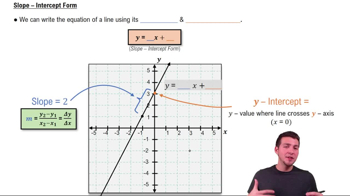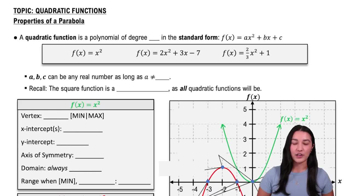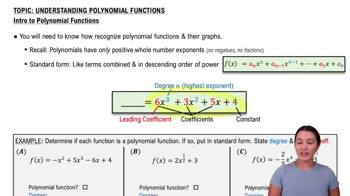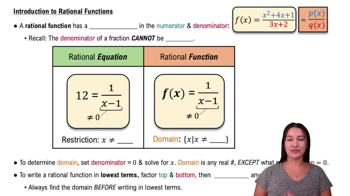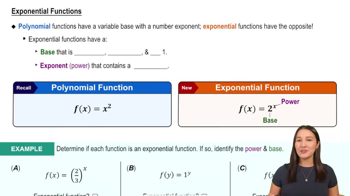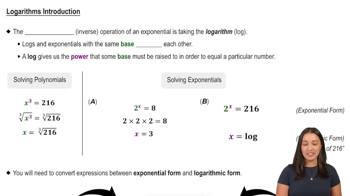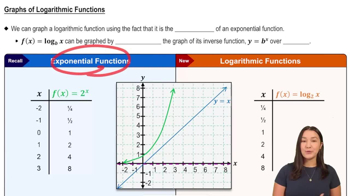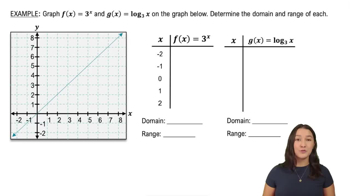Table of contents
- 0. Functions7h 52m
- Introduction to Functions16m
- Piecewise Functions10m
- Properties of Functions9m
- Common Functions1h 8m
- Transformations5m
- Combining Functions27m
- Exponent rules32m
- Exponential Functions28m
- Logarithmic Functions24m
- Properties of Logarithms34m
- Exponential & Logarithmic Equations35m
- Introduction to Trigonometric Functions38m
- Graphs of Trigonometric Functions44m
- Trigonometric Identities47m
- Inverse Trigonometric Functions48m
- 1. Limits and Continuity2h 2m
- 2. Intro to Derivatives1h 33m
- 3. Techniques of Differentiation3h 18m
- 4. Applications of Derivatives2h 38m
- 5. Graphical Applications of Derivatives6h 2m
- 6. Derivatives of Inverse, Exponential, & Logarithmic Functions2h 37m
- 7. Antiderivatives & Indefinite Integrals1h 26m
- 8. Definite Integrals4h 44m
- 9. Graphical Applications of Integrals2h 27m
- 10. Physics Applications of Integrals 2h 22m
0. Functions
Common Functions
Problem 1.R.12
Textbook Question
Assume f is an odd function and that both f and g are one-to-one. Use the (incomplete) graph of f and the graph of g to find the following function values. <IMAGE>
f⁻¹ (10)
 Verified step by step guidance
Verified step by step guidance1
Step 1: Understand the properties of odd functions. An odd function satisfies the condition f(-x) = -f(x) for all x in the domain of f.
Step 2: Recognize that f is one-to-one, meaning that each y-value in the range of f corresponds to exactly one x-value in the domain of f.
Step 3: Recall that the inverse function f⁻¹(y) gives the x-value such that f(x) = y.
Step 4: Since f is odd, if f(a) = 10, then f(-a) = -10. Use this property to find the x-value that corresponds to f(x) = 10.
Step 5: Use the graph of f to locate the x-value where f(x) = 10. This x-value is f⁻¹(10).
 Verified video answer for a similar problem:
Verified video answer for a similar problem:This video solution was recommended by our tutors as helpful for the problem above
Video duration:
2mPlay a video:
Was this helpful?
Key Concepts
Here are the essential concepts you must grasp in order to answer the question correctly.
Odd Functions
An odd function is defined by the property f(-x) = -f(x) for all x in its domain. This symmetry about the origin implies that the graph of an odd function will reflect across both axes. Understanding this property is crucial for analyzing the behavior of the function and its inverse, especially when determining specific function values.
Recommended video:

Properties of Functions
One-to-One Functions
A one-to-one function, or injective function, is one where each output is produced by exactly one input. This means that if f(a) = f(b), then a must equal b. This property is essential for the existence of an inverse function, as it ensures that the inverse will also be a function, allowing us to find values like f⁻¹(10) without ambiguity.
Recommended video:

One-Sided Limits
Inverse Functions
An inverse function essentially reverses the effect of the original function. If f(x) gives an output y, then f⁻¹(y) will return the input x. For one-to-one functions, the inverse can be found by swapping the roles of x and y in the equation y = f(x). Understanding how to find and interpret inverse functions is key to solving problems involving function values like f⁻¹(10).
Recommended video:

Inverse Cosine

 5:57m
5:57mWatch next
Master Graphs of Common Functions with a bite sized video explanation from Nick
Start learningRelated Videos
Related Practice



